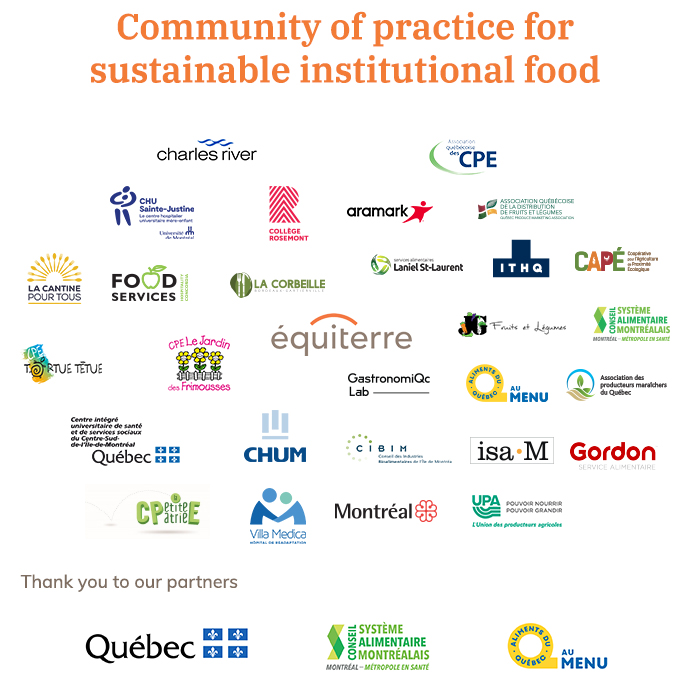Published on

In April 2020, Équiterre initiated a community of practice (Commun’assiette) for sustainable institutional food. Thanks to the support of its partners: the Système alimentaire montréalais, the Fondation du Grand Montréal, Aliments du Québec au menu, Commun’Assiette quickly raised enthusiasm for this environmentally responsible food procurement movement. In fact, more than 28 actors and experts in the institutional food sector including various regional and territorial authorities have joined this initiative.
During the first year of activities, 11 Montreal institutions representing all sectors (early childhood, school, Cegep, university, health, and work) participated in a quantification exercise to better understand just how much of their food purchases were sourced locally. Procurement is recognized as predominantly local if it represents 50% or more of their total annual budget.
In the picture, form left to right, Dominique Lacroix (Equiterre), Annie Lavoie (CHUM), Frédéric Duhamel (Jardin de Tessa), Catherine Noiseux (CHUM)
THE NUMBERS
Following the analysis of the quantification exercise carried out by Aliments du Québec au menu, the institutions have just received their results. They source on average 50% of their food from local suppliers (all categories of food).
More specifically,:
- 30% of the fresh fruit and vegetable category was sourced locally;
- 76% of the dairy products category was sourced locally;
- 61% of the protein category was sourced locally;
- 55% of the bakery and pastry category was sourced locally.

(only available in french)
WHY ARE THESE NUMBERS IMPORTANT?
These results are a great starting point, because we have little data on this subject in the institutional sector. They help us to understand where we are at and establish comparisons considering that currently Quebec produces approximately half of what the population eats. In addition, these results will also encourage institutions to set even more ambitious local food purchase targets for the coming year.
These figures are also very significant because they help the Quebec government to achieve its unifying project of increasing Quebec’s food autonomy. For the institutional sector, this project is reflected via the Stratégie nationale d’achat d’aliments québécois (SNAAQ). The SNAAQ is an ambitious strategy of the Québec government launched by the Minister of Agriculture, des Pêcheries et l’Alimentation du Québec (MAPAQ) André Lamontagne, which aims to significantly increase the share of local food purchased by public institutions in Quebec.
WHAT’S NEXT?
Building on the results of this quantification process, Commun’Assiette is ready to begin its second year of operations working to solidify and promote the community of practice with significant funding obtained following the deposit of a project by Équiterre for part 1 of the Programme de développement des marchés bioalimentaires within the SNAAQ.
For more information about Commun’Assiette or to become a member, please contact Lyne Royer. Follow our pioneering institutions and join the local food procurement movement. The recruitment period for the next cohort of institutions will take place during the fall of 2021.
PIONEER INSTITUTIONS OF THE FIRST COHORT FROM ALL SECTORS OF ACTIVITY
Charles Rivers Laboratories / Aramark
CHUM
CHU Sainte-Justine
CIUSSS Centre-sud de l'île de Montréal
Collège de Rosemont / Services alimentaires Laniel St-Laurent
CPE Jardin des frimousses
CPE Petite-Patrie
CPE Tortue têtue
Hôpital de réadaptation Villa Medica
La Cantine pour tous / La Corbeille
Université Concordia / Aramark






